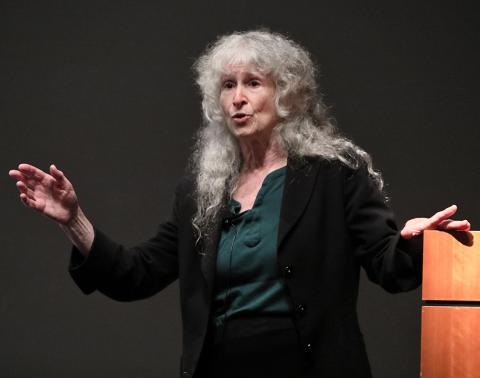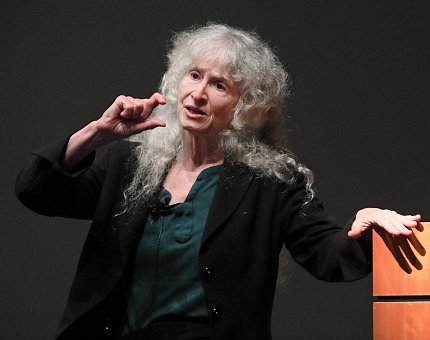Rothenberg Tracks T-Cell Education

Photo: Chia-Chi Charlie Chang
When he goes off to university, the T cell is not like his other high-achieving classmates. Rather than breezing through in the standard complement of time, T cells are on a kind of M.D./Ph.D. track, lingering in the thymus for as many as 2 rigorous weeks before committing irreversibly to the T-cell profession, which they will then faithfully follow wherever they go in the body.
Learning to become an immune cell takes time and trouble, explained Dr. Ellen Rothenberg, Albert Billings Ruddock professor of biology at the California Institute of Technology, in the final Wednesday Afternoon Lecture before summer break on June 27.
The T in T cell, like the H in Harvard, is not (necessarily) born to, but earned. Although the letter stands for thymus, seat of their learning, they actually arise in bone marrow. Arriving at the thymus as precursors, they still have the potential to be lawyers, doctors or tech titans. But as the semesters roll by, exposure to classmates—including Notch pathway activators and a limited set of growth factors—induces T cells to relinquish all other options in favor of T-ness.
Neighborhood is hugely important to immune cell fate, just as zip code correlates with chances of being admitted to the Ivy League. “Cells adopt new gene expression patterns depending on their environment,” said Rothenberg, who studies T-cell development in mice.
She described the thymus as a “coercive environment” wherein precursor T cells are slow to commit while under constant bombardment by competing biological signals; such hazing can last up to 2 weeks. “They give up multi-potentiality in the process,” Rothenberg said.
“This multi-step process involves a cascade of changes in the expression of different regulatory genes and resulting changes in global genome-wide activity,” she explained in a summary of her talk. “As the cells start their pathway to a T-cell fate, they come dangerously close to a gene-expression pattern typical of malignancy before they become safely locked into their T-cell identity.”
Just as some college students flirt with disaster before righting themselves, T cells go to some bars and clubs they might not want to frequent again. Rothenberg is keen to know how in development the T cell decides on its specific role rather than becoming a dendritic cell or an NK (natural killer) cell.
There are some 400 transcription factors vying for influence when precursor cells enter the thymus, Rothenberg said, but some are highly influential. One that is crucial to eventual T-cell fate is BCL11b, which is “needed for commitment, and correlated with commitment.”

Photo: Chia-Chi Charlie Chang
In a conversation following her talk, Rothenberg explains: “Honestly, the part about this that is most fascinating to me is that these transcription factors (including BCL11b) are really very concrete little proteins that bind to DNA and work as part of gene-expression machines. Their own expression depends on turning on the genes that encode them, just like any other genes. And yet their functions, in the end, have these wonderful qualities that can transform the entire biological role of a cell. The challenge for all of us in molecular developmental biology is to figure out how these little agents carry out their roles in determining cell identity.”
Rothenberg and her colleagues have spent the past few years examining exactly how transcription factors explain “developmental causality” of the changes that take place in cells. To understand this, she and her colleagues can effectively do molecular surgery on the developing cells to remove particular transcription factors at specific stages and see what the effect is on the cells’ next moves.
It turns out that BCL11b becomes like the main party organizer, determining what kind of social contacts a precursor makes. Notes Rothenberg, “Some cells stay adolescent and don’t grow up, depending on transcription factors.”
Within the precursor cell’s nucleus, BCL11b can also act as a kind of traffic controller for other transcription factors, including Runx 1, determining their own choices of genomic binding sites, she added.
T cell precursors still have another couple of weeks of thymic school to go through, even after they commit to being T cells, Rothenberg noted in a conversation following her lecture. “In fact, the worst is yet to come. More than 95 percent of each generation of aspiring T cells get killed off in the thymus, so that only a chosen 5 percent can be sent to ‘grad/professional school.’”
The good news, Rothenberg concluded, is that T-cell lineage identity, once established, is robust. You can’t take away the diploma once it is awarded.
In a brief Q&A session that preceded a reception in the NIH Library, Rothenberg fielded a number of questions that so intrigued her that it seemed she could happily spend her own next semester working alongside stimulating NIH colleagues.
The full talk is available at https://videocast.nih.gov/summary.asp?Live=28006&bhcp=1.
